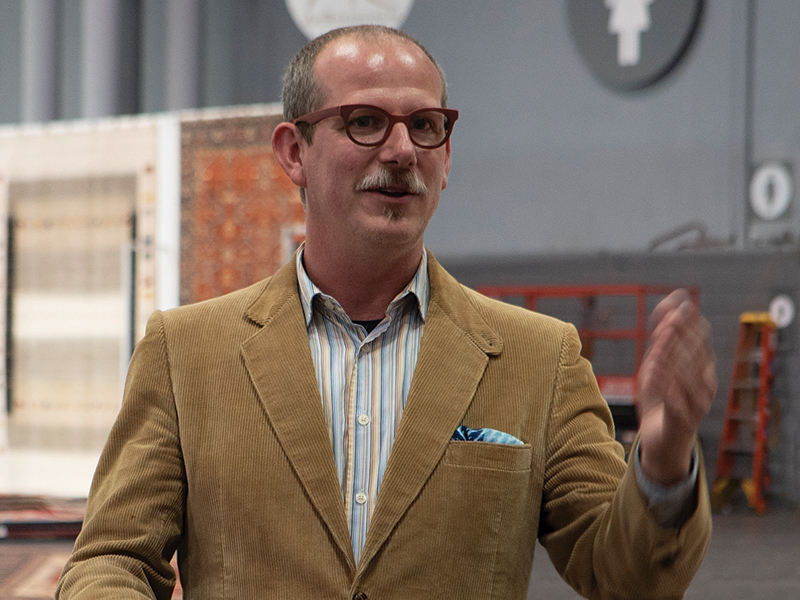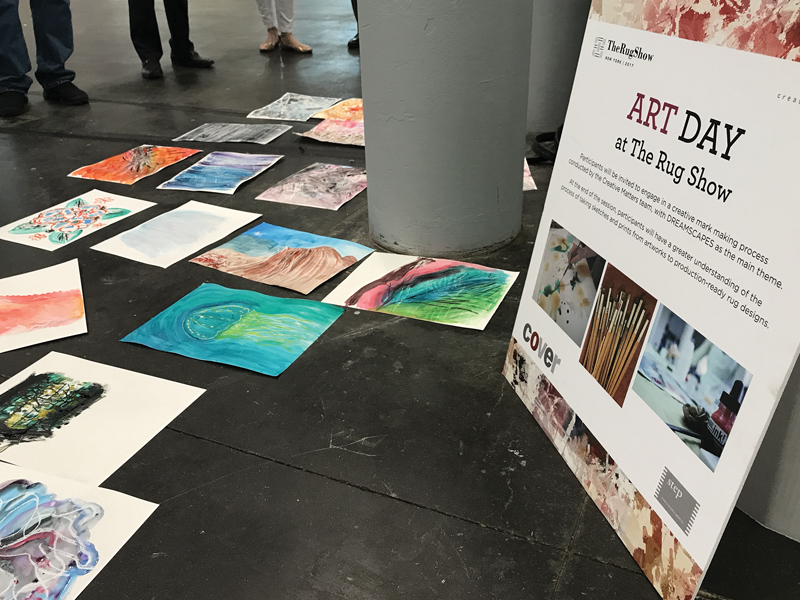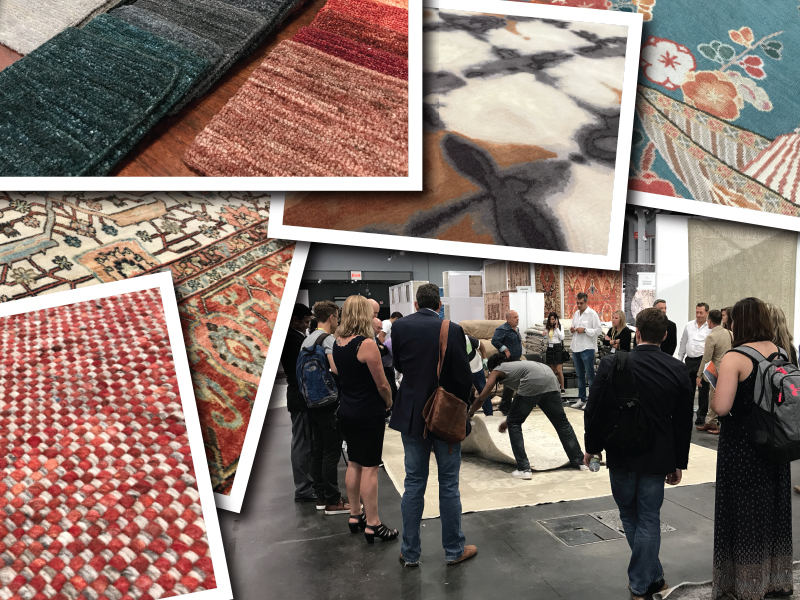As the current reigning preeminent trade show catering to the hand-knotted and handmade rug and carpet industry in North America, The Rug Show presents buyers and attendees a broad offering of aesthetics and qualities. It is also not the first show to lay claim to the title and as such Rug Insider looks at its origins and its future by asking aloud the murmuring questions.
In the fall of 2012 The Rug Show made its New York City debut running more or less concurrent with the other carpet shows then in New York; the New York International Carpet Show—NYICS as it was known—and Metro Market Week, MMW for short. Now, seven years later The Rug Show is the only exhibition that can lay claim to the moniker, “The New York Show”—as most shows in the city that never sleeps come to be known as colloquially within each niche industry. It remains North America’s only stand-alone show specifically for rugs and carpets, and particularly, the only one still catering to the business-to-business/importer/maker to retailer, model of distribution.
The Rug Show is held at the Javits Center in what is New York City’s soon to be extravagant Hudson Yards neighborhood, which revitalizes the city’s West Side. Hosting over one-hundred fifty conventions, shows, and events per year, the Javits is a world-class facility capable of supporting events ranging from the New York International Auto Show, RuPaul’s Drag Con, the International Contemporary Furniture Fair (ICFF) and of course, The Rug Show.
Our discussion of The Rug Show in New York however is less about the where, the when, or even The Rug Show in and of itself. We want to focus on how New York City came to have a fall show at all, and, more pressingly, whether it makes sense now and into the future. It is really a discussion of the fate of hand-knotted rugs in North America.
First, the why.
In the mid-oughts and certainly prior to the 2008 financial crisis, New York City was still home to a large community of rug importers and wholesalers. Many of them had and continued to exhibit at the North Oriental Rug Show—NORS—at AmericasMart in Atlanta, Georgia; “Atlanta” as it is still known. For various reasons no doubt related to cost and logistics many exhibitors longed for a show closer to home. Thus was born Metro Market Week, followed closely by the complementary New York International Carpet Show. Dennis Dodds lead NYICS while MMW was lead in part by David Samad, and in it’s later years, by RUG INSIDER Magazine. The years of the shows prior to and including 2012 saw great camaraderie and excitement, as well as great success for those involved.
As time wore on and the economy took its toll, importers either closed or, due to skyrocketing costs, moved outside the city. The resulting loss of local participants in MMW lead eventually to its demise. At the same time the NYICS continued to maintain a strong presence as “the New York show” of its time. In fact, the same year that saw The Rug Show debut in New York also saw the NYICS sell out of exhibitor space, further cementing New York City as the preferred destination for business to business rug buying. After several years of competition—friendly, or otherwise—between rival shows, The Rug Show claimed sole title as “the New York show” in 2017, bearing out my statement of September 7, 2012 “… let the best, in all its arbitrary and relative meanings, show win.” But The Rug Show did not start in New York (and that may be its saving grace).
The Rug Show’s origins began in 2009 when a predecessor, the “Los Angeles International Rug Show,” organized its first spring show. It was well positioned to cater to buyers from the Western portion of North America. Notable brands such as Wool and Silk, who would eventually exhibit in Los Angeles, saw the spring show as the perfect complement to their existing show circuit of Domotex Hannover in January and NYICS in September as it provided increased exposure and made it easy for their buyers.

Rug Insider Editor Michael Christie, The Ruggist, shown speaking during his “Under the Rug!” tour during the 2018 New York installment of The Rug Show. Christie will once again be leading the “Under the Rug!” tour at this year’s show, September 7-10, 2019.
Having evolved in 2012 into the more portably named “The Rug Show,” the firm is run and organized by a cooperative group of rug dealers based out of Los Angeles, California, namely Ramin Mobayen, who had been involved with the previous show. The Rug Show also states that it runs as a non-profit organization “to benefit the handmade rug industry.” This raises an interesting question that must be asked of said industry: “Does the current legacy distribution model have viability if it requires—in part—what is technically describable as charitable work?” or to ask from another perspective “Is this an industry recognizing excess and trimming down for efficiencies?” It seems the answer is likely a bit of both—but I digress.
By the time 2017 arrived, The Rug Show had put the west coast incarnation on hiatus and began exploring new venues such as an initial series of three appearances at the venerable home furnishings show, High Point Market. As of editorial deadline, the High Point The Rug Show is slated to return April 6-10 for its fourth appearance and the next “New York show” will take place on September 7-10, 2019. It is now the preeminent, if not the only, rug and carpet specific show in North America.
“… and to ‘promote the best interests of the Oriental Rug Trade in the United States and in countries that produce Oriental rugs.’ In 2019, these interests no longer align with the outmoded distribution models upon which The Rug Show and its predecessors are and were predicated. ‘Change or Die’ is more relevant than ever.“
In “Service Providers,” which appeared in the Winter 2019 issue of Rug Insider Magazine, Jack Simantob of Art Resources [Simantob is also one of the principals behind The Rug Show.] said, “Most retailers are no longer stockists operating a storefront where a customer comes in and leaves having purchased a rug from stock. Now they are service providers there to facilitate the sale of a rug.” By extension The Rug Show must no longer be just a place to go and buy rugs. Instead, it must be a place to buy, to meet new facilitators of rug production, to learn through educational programs and tours, and to network, thus building the connections imperative to running a successful rug retailing business in this era. For the most part, The Rug Show has succeeded in these regards. However, concerns hardly specific to the show remain; two examples highlight some of the challenges and opportunities facing the handmade rug and carpet industry as a whole.
It is one thing to say, as The Rug Show does, that it provides “The Premier Luxury Buying Experience,” and another thing to prove it. Gone are the days when being hand-knotted alone elevated a rug or carpet above the fray, and in an era with veritably unlimited access to information—text based, visual, or otherwise—it does not take perfect vision to see noticeable differences between the presentation style of The Rug Show and that of say ICFF, Domotex, IMM Cologne, High Point, Las Vegas, The AD Show, and the like.
Buyers told to expect “luxury” expect just that and as more shows, including The Rug Show, attempt to lure upmarket interior designers and architects as attendees and as potential customers, the delivered goods—be it a rug or the show experience—must meet expectations. And, as we all know, expectations are high for those considering the purchase of a floor covering in the many-thousands of dollars. True luxury experiences offer a presentation manner commensurate with the product offered and, having surveyed many trade shows and the work of some of the most successful rug dealers/retailers operating today, I can attest that those doing well understand not just the service Simantob reminds us of, but the presentation and quality as well.
“True luxury experiences offer a presentation manner commensurate with the product offered and, having surveyed many trade shows and the work of some of the most successful rug dealers/retailers operating today, I can attest that those doing well understand not just the service … but the presentation and quality as well.“
The second example is educational programs, and for this The Rug Show should and does receive the highest praise. By offering a diverse selection of programming catering to a variety of targeted attendee demographics, the organizers have cast a wide net in order to be the source of service and networking. Rug Insider has been involved with these efforts: I led the “Under the Rug” tours at last fall’s New York show, as has Cover Magazine, whose Editor Lucy Upward led two panel discussions at the same fair, “Scandinavian Modernism” and “Sustainable Luxury,” both of which garnered highly positive reviews. Other activities such as Creative Matters’ CEU accredited “Art Day” workshops have in the past added great energy and appeal to the show by offering non-traditional attendees a return on the investment of their time. In the post-truth environment of today, programs such as these that intend to educate and inform are more imperative than ever.

Creative Matters’ “Art Day” educational and CEU accredited program has proven to be quite popular with attendees of the fairs at which it is presented including The Rug Show.
So what is next? What are our thoughts for the future of ‘The New York Show?’ The same as they are for any business or show of this era: Oscar Tatosian’s sage advice from the article, “Oscar Isberian, Reflections on Success,” which also appeared in the Winter 2019 issue of Rug Insider: “Change or Die.”
Many of the reasons for “the New York show” to be in New York have evaporated; in a climate of globalism and rug buyers’ willingness to travel wherever there is a critical mass of product, the question—one without an obvious answer—must be: “Why New York?” The buyer demographic has also changed dramatically. While it was formerly rare for a rug showroom in North America to directly import rugs from the country of origin/production, it is now a commonplace occurrence. And one cannot bemoan this change while also welcoming interior designers and architects—formerly customers within the sole purview of the retailer—into a show. Instead, mustn’t we broadly rethink how hand-knotted rugs and carpets are distributed? In a word: No!
The distribution has already changed, is changing, and will continue to change with or without rethinking. The dwindling importance/prominence of hand-knotted goods due to competition from ever improving less expensive means of production is one factor. The rising cost of making hand-knotted rugs is another. Coupled with the rise of internet sales, shifting socio-economic demographics, and a political uncertainty which—regardless of ones own political leanings—drags consumer confidence and spending down, it is easy to understand a decline in luxury consumption. Less a rethinking of how hand-knotted rugs and carpets are distributed, we are confronted with the question of how hand-knotted rugs and carpets are to survive at all. And, then, how do trade shows such as The Rug Show fit into the current paradigm.
To paraphrase language used by The Rug Show, the now apparently defunct NYICS and to directly quote the mission statement of the Oriental Rug Importers Association, those involved in all these groups have at one time or another purported to promote rugs and carpets for the betterment of the industry … and to “promote the best interests of the Oriental Rug Trade in the United States and in countries that produce Oriental rugs.” In 2019, these interests no longer align with the outmoded distribution models upon which The Rug Show and its predecessors are and were predicated. “Change or Die” is more relevant than ever.
I am an unabashed fan of hand-knotted rugs and carpets and I also consider myself to be working toward the betterment of the entire industry. That is why I am asking these questions. That is why I seek to encourage dialogue among every interested and impacted party so that critically important shows such as The Rug Show do not too fall prey to the whims of history.
The Rug Show offers buyers—of all types—an increasingly rare sense of community and camaraderie. It is also the only current option for those seeking a true hand-knotted and handmade rug buying experience unencumbered by so-called celebrity interior designers, flashy live musical performances, and more social media hype than substance. Those exhibiting at The Rug Show care deeply about rugs and carpets, for collectively they are bearers of the venerable mantle of the rug trade in North America. It is a mantle worth not only preserving, but fostering and supporting in a flexible and responsive way so the market may hope to continue into the future. The show and its supporters—Rug Insider and myself included—have to adapt to these needs in order to genuinely work toward the betterment of the hand-knotted industry.
Does this mean The Rug Show should pivot to offer the polished luxury of ICFF or Maison et Objet? Not necessarily, but it does mean
examining what is working and what isn't in order to remain adaptive to the continually evolving luxury market.
I and Rug Insider consider The Rug Show to be, unequivocally, the current best option for hand-knotted rugs and carpets in North America and we shall continue to support it, praise it, critique it, and help improve it, so long as there are beautiful hand-knotted rugs to be sold.
Images: Photograph of Michael Christie speaking, courtesy of The Rug Show. Remaining images Rug Insider files.
